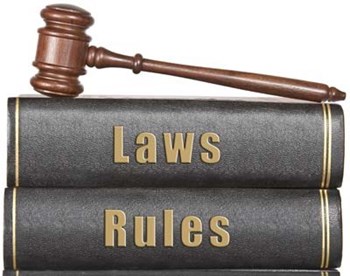
Differences and disputes happen. We’re only human, and that’s why laws and rules are in place. But, the federalist system of government we use in this country is far from the most efficient system. Layers and layers of laws, statutes, and regulations fall on associations.
First there’s the condominium declaration and bylaws. There are the house rules that can be separate from the bylaws. Then there are municipal codes and ordinances that can cover anything from how many trees need to be on the association’s property to plumbing to civil rights issues. On top of that, there are state laws and statutes drafted and passed by the Florida legislature; and finally, there are federal laws and regulations. Associations and their counsel need to keep abreast of all of them, because they all trump declarations and bylaws. What might seem fair on a federal level could be more complicated on a state level, and if your declarations are not up to date, silly legal issues can spiral out of control.
I Declare
When it comes to association rules and declarations, most states have laws in place that establish standards for how boards and associations should conduct their work. But, association bylaws and declarations are still a separate entity, and it's not always that state law simply trumps anything in the declarations, says Ben Solomon, an attorney and senior partner at the Association Law Group in Miami. Generally, when in conflict, “federal, state, or local laws will supersede restrictions under an association’s governing documents,” he says. “However, such association documents may be more restrictive than such laws, so long as they are not in conflict.” Since most board members are not trained real estate attorneys, there's no way for them to tell which law would be superseded and which wouldn't. “My advice to the client is, is to look to see how restrictive their rule is versus what the law is. If it totally changes it and flips it over, then most likely the law is going to trump,” says Rachel Frydman, an attorney and founding managing member at The Frydman Law Group PLLC in Plantation. “But if the rules that they have aren’t as restrictive as the law, then most likely their rule will likely stay in place. If you have a covenant restriction, then I go back to say ‘does this association have to follow the laws as they become amended, or are they allowed to stay within the current statute?’ There's analysis you have to do to see what law would trump what and what wouldn't,” she says.
If boards do find that their documents, whether they be bylaws or declarations, are not syncing up with new laws, Solomon says there are a few ways to react. “Although an amendment to the document that's in conflict would be ideal to make it comply with the current law, if the same can be achieved without overly burdening the association, technically the association doesn't need to do anything but comply with the new law regardless of the conflict under their own documents. The general rule on conflicts would govern, meaning that the new law would automatically supersede the conflict in the document,” he says.
Something Old, Something New...
A lot of the discrepancies that associations find they have with new laws usually involves technicalities. “For example they amended a document regarding fining. When they put fining in the statutes, it said 'unless your documents say otherwise, you fine up to $100 per day,' so you have to determine whether your documents have a certain dollar amount for a fine, or whether the statute's going to kick in,” says Frydman.
But other changes are much more sweeping and may even have heavy consequences. The most recent example is the Aventura Management v. the Spiaggia Ocean Condominium Association. “This case affected all association-owned condominium units, in that technically the association would not be entitled to recover the ‘safe harbor’ after the bank completes its foreclosure,” says Russell Robbins, a managing partner with the law firm of Mirza Basulto & Robbins LLP in Coral Springs. “The court determined that the association, in acquiring title to the unit at the association’s lien foreclosure sale became an ‘owner’ as defined in Florida statutes, and subjected to joint and several liability for the debt,” he says.
To cut through the legalese, Frydman explains that, “Associations are losing tens of thousands of dollars that they used to collect by third parties at foreclosure sales by banks. Now if the association has title for a certain period of time, even if it's one month, they can lose ten, twenty, thirty thousand dollars that the prior owner owed, but the association took title to and lost at the bank sale.”
The case is not just unpopular with condo owners, it's unpopular with attorneys who are forced to get creative in order to keep associations from getting too far into the red. “It's hoped that the legislature will see this gaping hole in the law that affects every condominium association in Florida and correct the statute to clarify that the association is not a ‘unit owner’ when acquiring title to a unit at its foreclosure sale,” says Robbins.
But financial issues aren't the only subjects of controversy. The United States is constantly in a state of social change, and when legislatures and courts respond, condo declarations can be part of it.
Fair housing policies, discrimination laws are the kinds of federal statutes that can powerfully affect how associations do business. Those federal laws and regulations usually say they can be superseded only if a local entity has a more strict law concerning the issue at hand. One of the more recent examples of federal policy affecting condos is senior communities.
Age-Restricted Communities
“When they had the no children rule, there was a change, I think in 1992, that said 'if you're going to restrict kids you have to have certain language and it has to measure the fair housing restriction with the 80 percent beginning 55 and older,' so there was certain language that had to be adopted in order for associations to restrict children from living there,” says Frydman. “There are times where the legislators will put something into effect and it is going to change your documents, but you have to go with the times and change your documents in order to meet what the law's going to require.”
Another hot button topic involves pets. “Some HOA documents prohibit having pets for example,” says Solomon. “However, there are legal exceptions under federal law for seeing eye dogs and other medically-necessary pets, which laws would supersede the pet restriction under the documents. Again, only if medically necessary though.”
Freedom of Speech
First amendment rights can also engender conflicts in associations. Free speech is a very coveted American democratic tradition, and it's not surprising that it can cause problems when unit owners are trying to maintain a uniform and well-maintained community. “I did have an association a few years ago with someone who put up some sort of flag he painted on his garage door,” says Frydman. “You're supposed to be allowed to display the flag, but it became above and beyond that time that it was causing an issue. I don't even think it was the American flag, it was the Confederate flag or something. We were trying to determine how far we were going to push his rights versus our rights, and eventually we settled it. But there are things that are going to conflict, and boards need to make a business decision about whether they want to become part of the news or do they want to try to work it out internally,” says Frydman.
Working things out among neighbors almost always makes for the most responsible and least painful way to resolve a dispute. “I recommend internal mediation, some sort of informal sit-down with the parties to hammer out what their issues are and what our issues are, so we can kind of work it out in the middle,” says Frydman. “With a formal mediation you have to pay somebody a lot of money, and they don't always help you. They just kind of facilitate the conversation, and if you're willing to have the conversation on your own, you don't really need it.”
Think Before Litigating
Unfortunately, the other option is litigation. The clients have to be willing to spend the money which they may not recover. Hopefully it gives them the outcome they're looking for, but I don't think that's a good way to spend association money,” she says.
That's why associations should maintain a healthy dose of empathy along with everything else. How statutes, regulations, ordinances and the like shake out can be messy, and sometimes just not make common sense. The best defense is to stay up to speed as much as possible, and have a great line of communication with your attorney.
Tom Lisi is an editorial assistant at The South Florida Cooperator and other publications.






11 Comments
Leave a Comment